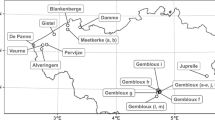Abstract
A total of 1244 egg-pods of 12 grasshopper species were collected — 26.7% were from low altitude hills, 23% from Swat valley, 22.1% from Punjab plains, 19.4% from Peshawar region and 8.8% from Potohar plateau. Aiolopus thalassinus was the dominant species comprising 27.7% of the total pods. This was followed by Shirakiacris shirakli (24.5%), Oxya multidentata (13.6%), Trilophidia annulata (9.7%), Spathosternum prasiniferum (9.7%), Atractomorpha acutipennis(7.4%), Stenohippus sp. (3.8%) and Phlaeoba punteli (1.8%). Others were rare being less than 1%.
Egg-pod density was effected by several closely related factors. Mean annual temperatures (15.6–23.4°C) and average precipitation (310–2100 mm) of the localities were not the ultimate controlling factors. Parasitism however, appears to play an important role. Highest parasitism of Scelio spp. was 10% on the Potohar plateau where egg-pod population was lowest. A. thalassinus was the most preferred host(41.7%) followed by S. prasiniferum (35.4%), S. shirakii (14.6%), O. multidentata (8.3%), T. annulata and Stenohippus sp. (2.1% each). Soil-type (clay-loam, loam, sandy-loam) and type of vegetationl(cultivated area, grasslands) also have a considerable bearing on the microclimate in which the insects live.
Résumé
Un total de 1244 gousses, avec les pourcentages suivants: 26.7% des collines, 23% de la valley de Swat, 22.1% des plaines du Punjab, 195 de la region du Peshawar et 8.8% du plateau du Potohar, contenant des oeufs de 12 espèces de sauterelles a été collecté. L’ espèce dominante avec 27.7% du total des gousses fut Aiolopus thalassinus, suivit du Shirakiacris shirakii (24.5%), Oxya multidentata (13.6%), Trilophidia annulata (9.7%), Spathosternum prasiniferum (9.7%), Atractomorpha acutipennis (7.4%), Stenohippus sp. (3.8%) et Phlaeoba panteli (1.8%). Les autres espèces très rares n’ont pas fait 1%. La densité des gousses contenant des oeufs fut affecté par des différents facteurs. La moyenne annuelle des temperatures (15.6–23.4° C) et de pluviometrie (310–2100 mm) de ces localités n’étaient pas de facteurs de contrôle efficaces. Par ailleurs le parasitisme semble jouer un role important. Un parasitisme de 10% fut enregistre sur le plateau du Potohar la ou le nombre de gousses contenants des oeufs étaient très bas.
Similar content being viewed by others
References
Brown V.K. (1983) Grasshoppers. Naturalists’ Handbooks 2. Cambridge University Press. Cambridge, London.
Clark E.J. (1948) Studies in the ecology of British grasshoppers. Trans. R. ent. Soc. Lond. 99, 173–222.
Dempster J.P. (1963) The population dynamics of grasshoppers and locusts. Bio. Rev. 38, 490–529.
Ghauri A.S.K. (1960) Insect pests of Pakistan. FAO Techn. Doc. 8, 1–31.
Greathead DJ. (1966) A brief survey of the effects of biotic factors on population of the desert locust. J. Appl. Ecol. 3, 239–250.
Irshad M., Ahmad M., Ghani M.A. and Ali R. (1978) Parasites of grasshopper (Acridoidea: Orthoptera) eggs: Distribution and life history of Scelio spp. (Hymenoptera: Scelionidae) in Pakistan. Can. Ent. 110, 449–454.
Metcalf CJL. and Flint W.P. (1951) Destructiv. and Useful Insects. McGraw-Hill Book Co. Inc. New York & London.
Pickford R. (1972) The effects of climatic factors on egg survival and fecundity in grasshoppers. In Proceedings of the International Study Conference on the Current and Future Problems of Acridology (Edited by Hemmings CF., and Taylor T.H.C.), pp. 257–260. London: Centre for Overseas Pest Research.
Putnam L.G. (1953) Observations on internal parasites (Hymenoptera: Scelionidae) of eggs of pest grasshopper species in the Prairie Province of Canada. Can. Ent. 85, 255–260.
Vestal D.G. (1913) Local distribution of grasshoppers in relation to plant associations. Bio. Bull. Mar. Bio. Lab. Woods Hole. 25, 141–180.
Waloff N. (1950) The egg-pods of British short-horned grasshoppers (Acrididae). Proceedings of the Royal Entomological Society of London, Series A. 25, 115–126.
Walter H. and Lieth H. (1960) Klimadiagram-Weltatlas. Klimadiagramme von Indien: 1–6. Veb. Gustav Fischer Verlag Jena.
Author information
Authors and Affiliations
Rights and permissions
About this article
Cite this article
Mahmood, T.Z., Qazi, M.H. Density and Parasitization of Grasshopper Egg-Pods in Pakistan. Int J Trop Insect Sci 10, 63–68 (1989). https://doi.org/10.1017/S1742758400003350
Received:
Revised:
Published:
Issue Date:
DOI: https://doi.org/10.1017/S1742758400003350




